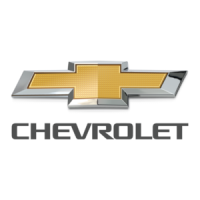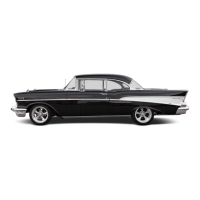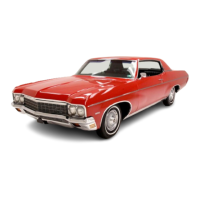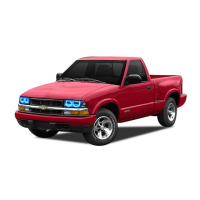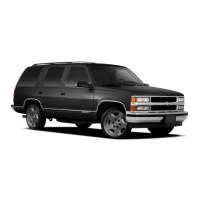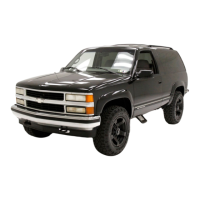Do you have a question about the Chevrolet 1953 and is the answer not in the manual?
Controls the ignition system with positions for locking, off, on, and starting.
Manages parking, tail, and instrument panel lights, with a second position for driving lights.
Operates independently of service brakes, applied by pulling a T-handle.
Controls windshield wipers and washer system, operated by turning and pressing a knob.
Controls the all-weather ventilating system by adjusting air flow through two knobs.
Describes the tilt-type ash tray and cigarette lighter operation.
Opened by a push button, can be locked with a key; some models have an automatic light.
Features an attractive arrangement for quick reading, with plastic arrows as direction signal indicators.
Shows engine coolant temperature and fuel level when ignition is on.
Indicates battery charging status and engine oil pressure.
Registers speed/mileage and controls the Air Flow heater system.
Describes radio tuning and controls, and how to set the illuminated clock.
Describes square-shaped foot pedals and the seat adjuster for comfort and control.
Pedal controls engine speed, designed for smooth control with proper "feel."
Details concealed door hinges with hold-open devices and crank-controlled ventipanes.
Adjustable sun visors for glare reduction and a rotatable rear view mirror.
Automatic and manual interior light switches; dome light operation.
Engine requirements for gasoline and oil, and location of the gasoline filler cap.
How to release the hood using the lever under the top grille bar.
Locating and checking engine/transmission oil levels and safely removing the radiator filler cap.
Operation of the single-key system and how to lock doors from inside and outside.
Describes the five transmission positions and the procedure for starting the engine.
How Powerglide automatically selects ranges for smooth driving based on accelerator input.
Guidelines for using "L" for steep grades/snow and "R" for backing up.
Important safety tips for operating the Powerglide transmission, like avoiding rapid selector changes.
Procedure for starting the engine by pushing or towing the vehicle.
Steps for starting the engine with a manual transmission, including clutch and accelerator use.
Explains gear shifting and the procedure for starting by pushing.
Use of special break-in oil for the first 500 miles and frequent oil level checks.
Specific speed limits for the first 500 miles to ensure proper engine component wear.
Instructions for safely lifting the car with the jack, including wheel blocking.
How to manage the rear wheel shield and care for the cooling system.
Keep system clean, use antifreeze, drain, and check for leaks for winter operation.
Preserving the car's finish with proper washing, polishing, and chrome cleaning methods.
Guidance on operating and caring for the convertible top fabric and plastic rear window.
Explains tire inflation effects and provides pressure settings for various conditions.
Importance of valve caps and rotating tires every 5000 miles for even wear.
Operation of switch, volume, tone, and tuning controls for manual radio use.
Procedure for pre-selecting and tuning stations using push buttons.
Using the "Temp" and "Blower-Air" knobs for temperature and air source control.
Specific settings for defrosting the windshield and for summer ventilation modes.
Recommended heater settings for various winter driving conditions like cold, sleet, and fog.
Recommended heater settings for summer driving, including hot weather and fogged windshields.
Initial engine oil fill and replacement recommendations after the break-in period.
Recommends SAE viscosity grades based on anticipated lowest atmospheric temperature.
Defines API oil types (ML, MM, MS, DG) for various service conditions.
Guidelines for oil changes every 2000-3000 miles and filter changes.
Refers to specific pages for the location of chassis lubrication points.
Lubrication steps for starter solenoid, generator, and transmission/rear axle.
Checking Powerglide fluid and lubricating steering gear.
Maintenance for distributor, battery water, radiator coolant, and shock absorbers.
Draining and refilling engine oil and servicing the air cleaner element.
Spark plug regapping, tire rotation, and rear spring lubrication.
Repacking front wheel bearings and lubricating brake/clutch pedals.
Lubricating gearshift control and servicing rear axle/transmission.
Location of car/engine numbers and recommended cold tire pressures.
Lists fluid capacities and details for various vehicle light bulbs.
Provides engine bore, stroke, displacement, horsepower, wheelbase, and valve/plug clearances.
Lists fuse capacities, locations, and explains the thermal circuit breaker's role.
Cautionary notes on handling the battery, avoiding sparks, and grounding the car.
Controls the ignition system with positions for locking, off, on, and starting.
Manages parking, tail, and instrument panel lights, with a second position for driving lights.
Operates independently of service brakes, applied by pulling a T-handle.
Controls windshield wipers and washer system, operated by turning and pressing a knob.
Controls the all-weather ventilating system by adjusting air flow through two knobs.
Describes the tilt-type ash tray and cigarette lighter operation.
Opened by a push button, can be locked with a key; some models have an automatic light.
Features an attractive arrangement for quick reading, with plastic arrows as direction signal indicators.
Shows engine coolant temperature and fuel level when ignition is on.
Indicates battery charging status and engine oil pressure.
Registers speed/mileage and controls the Air Flow heater system.
Describes radio tuning and controls, and how to set the illuminated clock.
Describes square-shaped foot pedals and the seat adjuster for comfort and control.
Pedal controls engine speed, designed for smooth control with proper "feel."
Details concealed door hinges with hold-open devices and crank-controlled ventipanes.
Adjustable sun visors for glare reduction and a rotatable rear view mirror.
Automatic and manual interior light switches; dome light operation.
Engine requirements for gasoline and oil, and location of the gasoline filler cap.
How to release the hood using the lever under the top grille bar.
Locating and checking engine/transmission oil levels and safely removing the radiator filler cap.
Operation of the single-key system and how to lock doors from inside and outside.
Describes the five transmission positions and the procedure for starting the engine.
How Powerglide automatically selects ranges for smooth driving based on accelerator input.
Guidelines for using "L" for steep grades/snow and "R" for backing up.
Important safety tips for operating the Powerglide transmission, like avoiding rapid selector changes.
Procedure for starting the engine by pushing or towing the vehicle.
Steps for starting the engine with a manual transmission, including clutch and accelerator use.
Explains gear shifting and the procedure for starting by pushing.
Use of special break-in oil for the first 500 miles and frequent oil level checks.
Specific speed limits for the first 500 miles to ensure proper engine component wear.
Instructions for safely lifting the car with the jack, including wheel blocking.
How to manage the rear wheel shield and care for the cooling system.
Keep system clean, use antifreeze, drain, and check for leaks for winter operation.
Preserving the car's finish with proper washing, polishing, and chrome cleaning methods.
Guidance on operating and caring for the convertible top fabric and plastic rear window.
Explains tire inflation effects and provides pressure settings for various conditions.
Importance of valve caps and rotating tires every 5000 miles for even wear.
Operation of switch, volume, tone, and tuning controls for manual radio use.
Procedure for pre-selecting and tuning stations using push buttons.
Using the "Temp" and "Blower-Air" knobs for temperature and air source control.
Specific settings for defrosting the windshield and for summer ventilation modes.
Recommended heater settings for various winter driving conditions like cold, sleet, and fog.
Recommended heater settings for summer driving, including hot weather and fogged windshields.
Initial engine oil fill and replacement recommendations after the break-in period.
Recommends SAE viscosity grades based on anticipated lowest atmospheric temperature.
Defines API oil types (ML, MM, MS, DG) for various service conditions.
Guidelines for oil changes every 2000-3000 miles and filter changes.
Refers to specific pages for the location of chassis lubrication points.
Lubrication steps for starter solenoid, generator, and transmission/rear axle.
Checking Powerglide fluid and lubricating steering gear.
Maintenance for distributor, battery water, radiator coolant, and shock absorbers.
Draining and refilling engine oil and servicing the air cleaner element.
Spark plug regapping, tire rotation, and rear spring lubrication.
Repacking front wheel bearings and lubricating brake/clutch pedals.
Lubricating gearshift control and servicing rear axle/transmission.
Location of car/engine numbers and recommended cold tire pressures.
Lists fluid capacities and details for various vehicle light bulbs.
Provides engine bore, stroke, displacement, horsepower, wheelbase, and valve/plug clearances.
Lists fuse capacities, locations, and explains the thermal circuit breaker's role.
Cautionary notes on handling the battery, avoiding sparks, and grounding the car.
| Brand | Chevrolet |
|---|---|
| Model | 1953 |
| Category | Automobile |
| Language | English |
